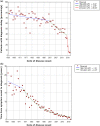Diagnostic delay in rare diseases: data from the Spanish rare diseases patient registry
- PMID: 36397119
- PMCID: PMC9670379
- DOI: 10.1186/s13023-022-02530-3
Diagnostic delay in rare diseases: data from the Spanish rare diseases patient registry
Abstract
Background: According to the International Rare Diseases Research Consortium (IRDiRC), a known rare disease (RD) should be diagnosable within a year. This study sought: firstly, to ascertain how long it takes to obtain the diagnosis of a RD in Spain, along with its associated time trend; and secondly, to identify and measure diagnostic delay (defined by the IRDiRC as any period exceeding a year) by reference to the characteristics of RDs and the persons affected by them.
Methods: Using data sourced from the Spanish Rare Diseases Patient Registry, we performed a descriptive analysis of the time elapsed between symptom onset and diagnosis of each RD, by sex, age and date of symptom onset, and type of RD. We analysed the time trend across the period 1960-2021 and possible change points, using a Joinpoint regression model and assuming a Poisson distribution. The multivariate analysis was completed with backward stepwise logistic regression.
Results: Detailed information was obtained on 3304 persons with RDs: 56.4% had experienced delay in diagnosis of their RDs, with the mean time taken being 6.18 years (median = 2; IQR 0.2-7.5). Both the percentage of patients with diagnostic delay and the average time to diagnosis underwent a significant reduction across the study period (p < 0.001). There was a higher percentage of diagnostic delays: in women (OR 1.25; 95% CI 1.07-1.45); in cases with symptom onset at age 30-44 years (OR 1.48; 95% CI 1.19-1.84): and when analysed by type of RD, in mental and behavioural disorders (OR 4.21; 95% CI 2.26-7.85), followed by RDs of the nervous system (OR 1.39; 95% CI 1.02-1.88).
Conclusions: This is the first study to quantify time to diagnosis of RDs in Spain, based on data from a national registry open to any RD. Since over half of all persons affected by RDs experience delay in diagnosis, new studies are needed to ascertain the factors associated with this delay and the implications this has on the lives of patients and their families.
Keywords: Diagnostic delay; Patient registry; Public health; Rare diseases; Spain; Time to diagnosis.
© 2022. The Author(s).
Conflict of interest statement
The authors declare no potential conflicts of interest.
Figures



References
-
- Alonso V, Villaverde-Hueso A, Hens M, Morales-Piga A, Abaitua I, de la Posada PM. Public health research on rare diseases. Georgian Med News. 2011;193:11–6. - PubMed
-
- Chazal PE, Chalandon AS, Aymé S, Deleuze C. Diagnostic delay in rare diseases: a documented list of (296) rare diseases for which delayed diagnosis would be especially detrimental, based on the French situation. 2020. Preprint available at Research Square:10.21203/rs.3.rs-32308/v1.
Publication types
MeSH terms
LinkOut - more resources
Full Text Sources
Medical
Miscellaneous

